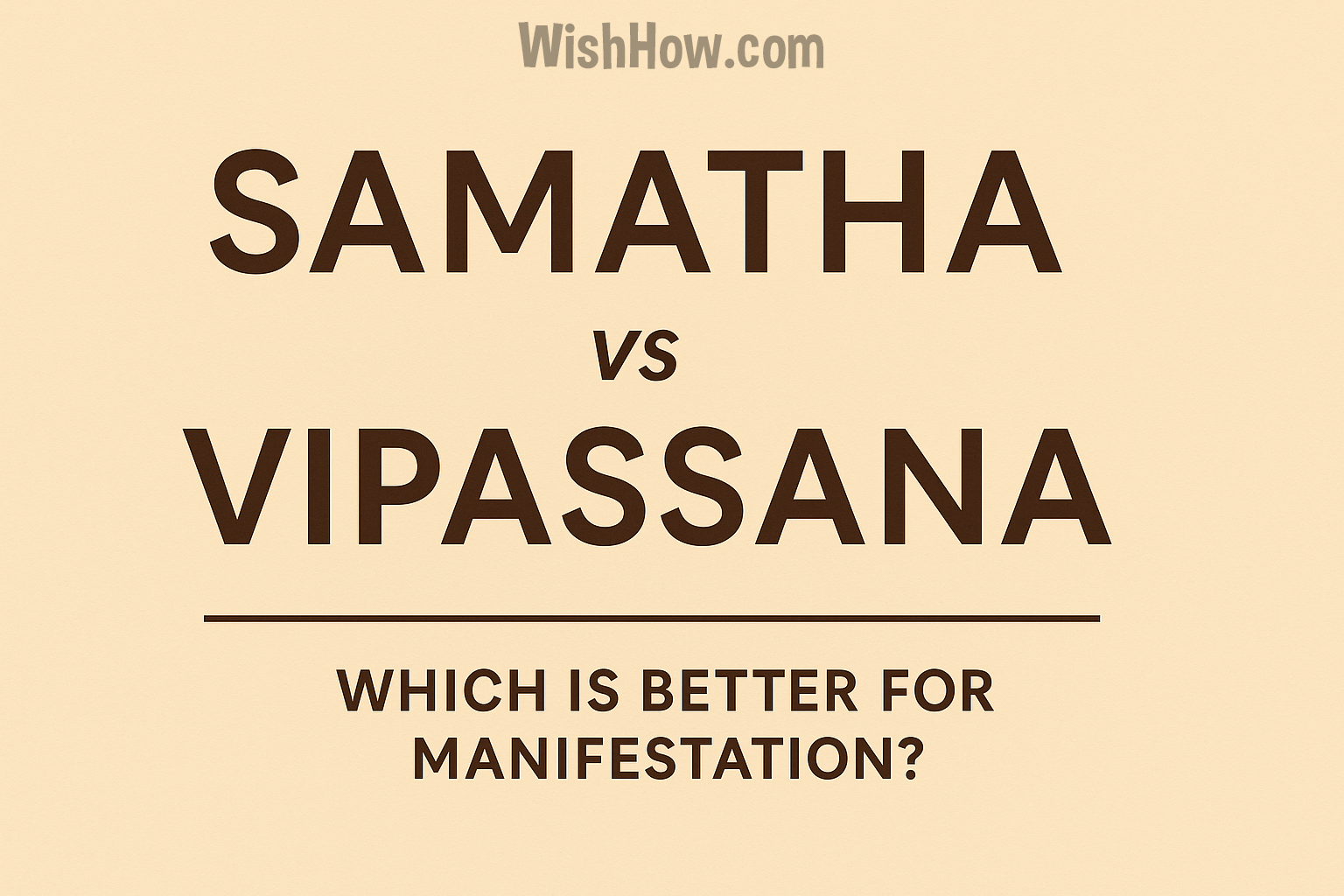Introduction: Why This Comparison Matters for Manifestation
In the world of manifestation, meditation plays a pivotal role in aligning our thoughts, emotions, and energy with our desires. Among the many meditation techniques available, Samatha and Vipassana stand out for their deep roots in Buddhist tradition and their transformative potential. While both are powerful in their own right, they serve different purposes and have different strengths. So, what exactly are the differences between samatha and vipassana meditation types? And more importantly, which one is better suited for helping you manifest the life you want?

What Is Samatha Meditation?
Samatha means “calm abiding” in the Pali language and is often referred to as concentration or tranquility meditation. Its primary goal is to cultivate a serene and focused mind. Practitioners typically concentrate on a single object, such as the breath, a candle flame, or a repeated word or phrase (mantra).
Samatha originates from ancient Buddhist teachings and is widely practiced in Theravāda and Tibetan traditions. It aims to stabilize the mind, allowing you to enter deeper meditative states, often referred to as jhanas (absorption states).
Core features of Samatha:
- One-pointed concentration
- Deep mental stillness
- Reduction of mental chatter
- Foundation for deeper spiritual insight
What Is Vipassana Meditation?
Vipassana, meaning “insight” in Pali, is a meditation practice focused on developing clear awareness and understanding of the nature of reality. Rather than concentrating on one object, Vipassana involves observing whatever arises in the body and mind—sensations, thoughts, emotions—without attachment or judgment.
This form of meditation is prominent in Theravāda Buddhism and forms the basis of many modern mindfulness practices.
Core features of Vipassana:
- Open awareness of the present moment
- Observation of impermanence (anicca), suffering (dukkha), and non-self (anattā)
- Detachment from cravings and aversions
- Profound personal insight and emotional clarity
Key Differences Between Samatha and Vipassana Meditation
| Feature | Samatha | Vipassana |
|---|---|---|
| Goal | Calm and focus | Insight and awareness |
| Technique | Focused attention | Open monitoring |
| Result | Tranquility, inner peace | Wisdom, clarity |
| Use in Practice | Foundation for insight | Insight into the nature of reality |

How Each Meditation Supports Manifestation
Samatha and Manifestation:
Samatha meditation excels at calming the mind, making it easier to focus on positive intentions and visualize desired outcomes. When your mind is peaceful, you can more easily direct your energy toward goals, repeat affirmations, and enter the emotional state of already having what you want. This calm mental state is fertile ground for setting intentions and manifesting with clarity.
Vipassana and Manifestation:
Vipassana offers the unique benefit of helping you observe and release subconscious patterns that block manifestation. By cultivating awareness of your thoughts and emotional responses, you begin to identify limiting beliefs and habitual negativity. This practice leads to powerful inner transformation, allowing you to clear space for new possibilities and align more authentically with your desires.
Pros and Cons of Each for Manifestation Goals
Samatha Pros:
- Ideal for beginners due to its simplicity
- Enhances concentration and emotional calm
- Supports visualization and affirmation techniques
Samatha Cons:
Living Untethered: Beyond the Human Predicament
$12.03 (as of April 28, 2025 21:51 GMT -07:00 - More infoProduct prices and availability are accurate as of the date/time indicated and are subject to change. Any price and availability information displayed on [relevant Amazon Site(s), as applicable] at the time of purchase will apply to the purchase of this product.)- May not address deeper emotional blocks or negative patterns
- Can foster a reliance on controlling the mind
Vipassana Pros:
- Encourages self-awareness and emotional healing
- Helps dismantle subconscious resistance
- Promotes long-term clarity and mental freedom
Vipassana Cons:
- Can be emotionally intense for some
- May take longer to notice external results
Can You Combine Samatha and Vipassana?
Yes, and many traditions recommend doing exactly that. Samatha is often used as a preparatory practice to calm the mind before transitioning into Vipassana. When you start with Samatha, you gain the stability needed to observe your inner experiences more clearly in Vipassana.
Sample structure for a combined practice:
- 10 minutes of breath-focused Samatha to calm the mind
- 20 minutes of Vipassana to observe thoughts and sensations
This synergy allows you to benefit from both calm concentration and deep insight—a powerful combination for manifesting from a place of clarity and alignment.

Which One Is Better for Manifestation?
There is no one-size-fits-all answer. The better option depends on your unique goals:
- If you’re looking to focus your mind, amplify visualizations, and align with your emotions, Samatha is a great choice.
- If your goal is to clear inner resistance, overcome limiting beliefs, and transform from the inside out, Vipassana may be more beneficial.
Ultimately, both practices complement each other beautifully and can be integrated into a manifestation routine.
How to Get Started with Each Practice
For Samatha:
- Sit comfortably and bring your attention to your breath.
- Gently bring your mind back when it wanders.
- Use a timer to begin with 5-10 minute sessions.
- Apps like Insight Timer or Headspace offer guided sessions.
For Vipassana:
- Begin with a body scan or simply notice your breath.
- Allow thoughts and sensations to arise without judgment.
- Label experiences (e.g., “thinking,” “hearing,” “feeling”) to stay present.
- Consider attending a 10-day Vipassana retreat for immersive experience.
Final Thoughts: Finding Your Meditation Style for Manifestation
Whether you choose Samatha, Vipassana, or both, the key is consistency and inner connection. Samatha will help you calm and direct your mind toward what you want. Vipassana will help you let go of what holds you back. Together, they offer a complete path to mental clarity, emotional balance, and manifestation success.
Meditation is not just a tool to get what you want—it is a practice that helps you become who you need to be to receive it.
Also Read: Meditation with Incense – 6 Powerful Reasons to Try It
FAQ: Samatha vs Vipassana for Manifestation
1. Can I use Samatha or Vipassana without following Buddhism?
Yes, both Samatha and Vipassana can be practiced without adhering to any religious beliefs. While rooted in Buddhist traditions, these techniques are secular and accessible to anyone interested in mindfulness, focus, or self-growth.
Self-Compassion: The Proven Power of Being Kind to Yourself
$12.09 (as of April 28, 2025 21:51 GMT -07:00 - More infoProduct prices and availability are accurate as of the date/time indicated and are subject to change. Any price and availability information displayed on [relevant Amazon Site(s), as applicable] at the time of purchase will apply to the purchase of this product.)2. How long does it take to see results from Samatha or Vipassana meditation?
Results vary by individual and consistency. Some people notice improved focus and calmness within a few days of Samatha practice, while the deeper insights of Vipassana may take weeks or months of regular meditation to emerge.
3. Do I need a teacher or retreat to start Vipassana meditation?
While not mandatory, learning Vipassana from an experienced teacher or attending a retreat can provide clarity, structure, and support—especially since the practice can uncover deep emotional patterns.
4. Is one type of meditation harder than the other?
Many beginners find Samatha easier to start with because it involves focusing on a single object. Vipassana can be more challenging due to its open-ended awareness and emotional intensity, but it offers transformative insight over time.
5. Can I use guided meditations for Samatha or Vipassana?
Yes. Many meditation apps and online resources offer guided sessions tailored to both practices. Samatha guides typically focus on breath awareness, while Vipassana guides may include body scans or mindful observation.
6. How do I know if I’m making progress in either practice?
In Samatha, progress often feels like deeper calm, longer focus spans, and emotional steadiness. In Vipassana, you may notice clearer awareness, reduced reactivity, and increased insight into your thought patterns and habits.
7. Which meditation is better for removing self-doubt in manifestation?
Vipassana may be more effective for uprooting self-doubt, as it encourages mindful awareness of limiting beliefs and emotional blocks that might hinder your manifestation efforts.







